
The origin of the colors black, red and gold
The combination of the colours black, red and gold goes far back in the history of the German Empire. The coat of arms of the Holy Roman Empire of German Nation showed a black eagle on golden ground. Its claws and the beak were coloured in red since the 13th/14th century. Oldest witness for that is the ca. in 1300 created "Heidelberg Song Manuscript Manesse".³Already in the year 1184, on the Hoftag (court day) in Mainz, the colours black, red and gold should have been named as "German Colours".³
As the Staufer Frederic I. "Barbarossa" was crowned in the year 1152 in Frankfurt to the German King, the way to the place of coronation should have been floord on desire of the Staufers with an expressly for that prepared carpet in black, red and gold. After the coronation the carped should have been cutted up in small pieces and given to the people as keepsake.³
In the year 1212 Archbishop Siegfried III. of Epstein crowned the Staufer Frederic II. to the German King in the cathedral in Mainz. Here Frederic weared a coronation coat in the colours red, black and gold. That coat was in use for the most coronations of the German kings and emperors until the end of the Holy Roman Empire of German Nation (1806).³
In the German Pawn War, an anti-feudal revolt in the years 1524/1525, 800 farmers assembled for the fight in the County of Stuehlingen in the Schwarzwald Area under a banner in the colours black, red and gold.³
In the Freedom Wars against Napoléon founded Ludwig Adolf Wilhelm Baron von Luetzow (1782–1834), a Prussian military officer in rank of a major, in the February of the year 1813, the Luetzow Free Corps, named also "Luetzow Hunters" or "Black Bevy". This military unit was recruited from voluntary fighters from different German states, and was in this way the vanguard of a national inspired people's army. Two thirds of the Lutzow hunters came out of the Confederation of the Rhine States and from Tyrol, one third were Prussians.²
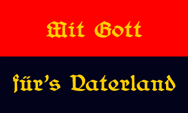
1813, Recruitment banner of Luetzow Free Corps


The Lutzow Corps had a banner, that was not shown in combat or in the order of march (light troops hab in Prussia to the end of the year 1815 no own flag), but only for purposes of recruitment. It showed two stripes in red and black, and the inscription "With God for the Fatherland". This banner hung on the wall in the relevant recruitment bureau of the corps, actually above the table on which the new recruit contributed his signature. It hung first in Breslau in the Inn "At the Golden Scepter" and then wherever the Luetzow Free Corps just halted and enlisted new fighters. That made this flag very popular, and so the visual design of the Jena fraternity flag from 1816 is very well to understand.²
However, the Corps was indeed part of the regular Prussian army, but it only belonged to the light infantry of the line, but it was used for specific purposes, such as for guerrilla tactics, forcible reconnaissance, pursuit and for outings. It has been proven well or even very good, for example near Bremen and at the Goehrde River. For these merits the corps was adopted into the regular line of the Prussian army, after the abdication of Napoleon (1814). The Luetzow Infantry became the 25th Infantry Regiment, the Luetzow Cavalry became the 6th Ulanen Regiment and the Luetzow Artillery became to the Horse-Battery No. 14.²
Karl-Theodor Koerner (1791–1813) celebrated this corps in his poem "Luetzow's wild, audacious hunt", and made their black uniform with the red cuffs and golden knobs with the black caps and the black-red-golden cockade very popular.²
In the afteryears many former Luetzow Hunters weared their uniforms as a student fellowship outfit in the Thuringian town Jena. The fellowship needed a flag, and in this way Amalia Nitsche created a flag in the year 1816, which, inspired by the outfit of the students, showed for the first time the colors black, red and gold. This flag showed three horizontal stripes in the colors red, black and red, and the black middle stripe carryed a golden oak leaf. The colors black, red and gold gradually spread out over the student propagation and stood in whole Germany for national and republican circles, which want to outgrow over the splitted German small states and their monarchies.
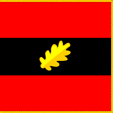
1816, Flag of the Student Luetzow Fellowship in the Town of Jena


At the only by students characterized Wartburg Festival in the year 1817 (performed to remember the Reformation and the Leipzig Battle of Nations) and at the Hambach Festival in the year 1832, which now was already supported by wide circles in the population, were showed for the first time black-red-golden flags, however in different arrangements of the stripes.
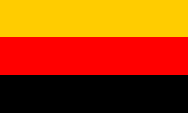
1817, German flag at the Wartburg Festival


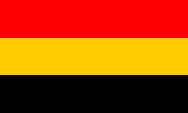
1832, German flag at the Hambach Festival


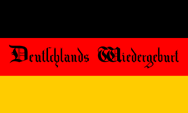
1832, German flag at the Hambach Festival


As possible motives for the adoption of the Farben colors black, red and gold as all-german colors count the following theories:
• direct adoption as colors of the Luetzow hunters and students
• identification of the colors as new colors of the empire, which go back to the colors of the coat of arms of the Holy Roman Empire of German Nation: black eagle with red armaments on golden ground
• addition of the hitherto empire's colors black and gold by the color red, which is characterized since the French revolution as the color of freedom, and therewith creation of a tricolor by French pattern.
When it came in Germany from March 1848 to the bourgeois revolution, the black-red-golden flag became the flag of the rebellious citizens. After fruitless and senseless bloodshed Friedrich Wilhelm IV., King of Prussia, lets remove the military from Berlin and went on a rode round on 21st of March in 1848 with a black-red-golden armband to show his will to make concessions, and to end the bloodshed. The black-red-gold flag graced then, in May 1848, the opening of the national assembly in the Pauls Church in Frankfurt and it was finally adopted as the national flag.

1848–1850, National flag of the German Confederation



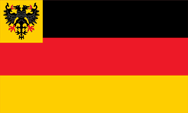
1848–1850, War flag of the German Confederation


Federal Act about Coats of Arms and Colours of the German Confederation (only in German language) → tap or click here.
After the failure of the revolution and the dissolution of the national assembly the flag became banished as all-german symbol in the year 1850 by the Prussian king, although it was in use by the Austrian troops in the year 1864 in the German-Danish War.
In the German War of 1866-67 (also alled Prussian-Austrian War or Fratricidal War) the troops of the Federal Army Corps weared partly black-red-golden armbands. Not least because of that fact the colors black, red and gold were felt in Prussia as the colors of the enemy. After Prussia's victory in the German War the initiatives for the unification of the empire came from Prussia, so that the North German Confederation and later even the German Empire did not introduce a black-red-golden but a black-white-red flag. Bismarck so spoke to in 1871: "If you like, green and yellow, and dances, or the flag of Mecklenburg-Strelitz. But the Prussian Troupier (he meant the future Emperor Wilhelm I.) wants nothing to do with black, red and yellow."²
Not until the successful civic revolution of the year 1918 the black-red-golden flag came to honors again, and was introduced on 11th of August in 1919 as national flag of the German Empire. On the 13th of March in 1933 the black-red-golden flag was abolished by the national socialists again.
Source: Volker Preuß, (2)Jürgen Kaltschmitt, (3)Deutschlandfunk
